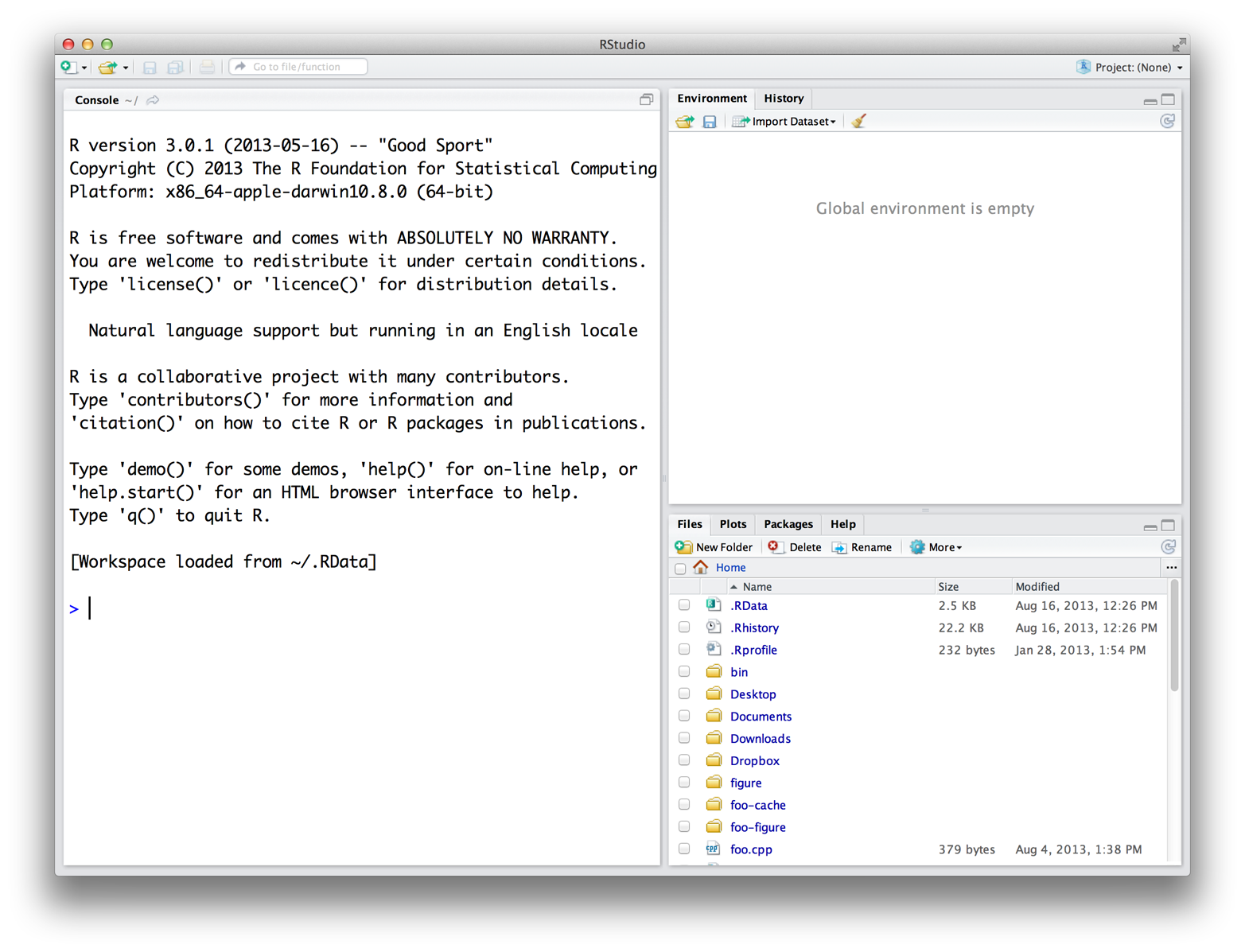Manually install (Recommended if you don't care about the old packages) The first method is to. RStudio provides free and open source tools for R and enterprise-ready professional software for data science teams to develop and share their work at scale.
- R-studio 3.6 Download Mac High Sierra
- R-studio Mac Download
- R Studio Download Free
- Download R Studio For Free On Mac
Every time there is a new major update from The RFoundation (like the recent 3.6.0release in April). I'm always happy to seethe continuing progress and the combination of new features and bugfixes, but I also dread the upgrade because it means I have to addressthe issue of what to do about the burgeoning number of packages(libraries) I have installed.
Up until now I confess I simply have sort of 'winged it', done theupgrade and either manually thought about what packages I 'really'needed or just grabbed a few essentials and then let my needs dictatewhatever else I reloaded. This time I decided to get serious about theprocess and pay attention to not only what I was doing but documentingit and keeping a record via some amount of coding (and this post).
I'm aware that there are full-fledged packagemanagers likepackrat and checkpoint and even a package designed to manage theupgrade for you on windows, but I'm a Mac user and wanted to do thingsmy own way and I don't need that level of sophistication.
So I set out to do the following:
- Capture a list of everything I had installed under
R 3.5.3and,very importantly, as much as I could about where I got the packagee.g.CRANorGitHubor ??? - Keep a copy for my own edification and potential future use.
- Do a clean
R 3.6.0install and not copy any library directoriesmanually. - Take a look at the list I produced in #1 above but mainly to justdownload and install the exact same packages if I can find them.
- Make the process mainly scripted and automatic and available againfor the future.
Helpful background
R-studio 3.6 Download Mac High Sierra
As I was searching the web I found a few helpful posts that saved metime in building my own solution. The primary was thisposton Stack Overflow. I wanted to extend the function listed there to doa little more of my work for me. Instead of just being able to generatea listing of what I had installed from GitHub I wanted to be able todetermine most of the places I get packages from, which are CRAN,GitHub and R-Forge.
So let's load tidyverse to have access to all it's various functionsand features and then build a dataframe called allmypackages with thebasic information about the packages I currently have installed in R3.5.3.
Note - I'm writing this after already upgrading so there will be a fewinconsistencies in the output
- This could just as easily be a
tibblebut I choseas.data.frame - I am deliberately removing base packages from the dataframe by
filter - I am eliminating columns I really don't care about with
select
A function to do the hard work
As I mentioned above the stack overflow post was a good start but Iwanted more information from the function. Rather than TRUE/FALSE to isit github I would like as much information as possible about where I gotthe package. The package~source function will be applied to thePackage column for each row of our dataframe. For exampleas.character(packageDescription('ggplot2')$Repository) will get back'CRAN', and as.character(packageDescription('CHAID')$Repository)will yield 'R-Forge'. For GitHub packages the result is character(0)which has a length of zero. So we'll test with an if else clause. Ifwe get an answer like 'CRAN' we'll just return it. If not, we'll seeif there is a GitHub repo listed withas.character(packageDescription(pkg)$GithubRepo) as well as a GitHubusername as.character(packageDescription(pkg)$GithubUsername). If theyexist we'll concatenate and return. If not we'll return 'Other'. Besidesbeing good defensive programming this may catch the package you havebuilt for yourself as is the case for me.
What's in your libraries?
Now that we have the package_source function we can add a column toour data frame and do a little looking.
And just to be on the safe side we'll also write a copy out as a csvfile so we have it around in case we ever need to refer back.
Go ahead and install R 3.6.0
At this point we have what we need, so go ahead and download and installR 3.6.0. At the end of the installation process you'll have a pristinecopy with a new library directory. When next you restart R and R Studioyou'll see a clean new version. Let's make use of our data frame toautomate most of the process of getting nice clean copies of thelibraries we want.
We'll start by getting the entire tidyverse since we need severalparts and because installing it will trigger the installation of quite afew dependencies and bootstrap our work.
Now we have R 3.6.0 and some additional packages. Let's see what we cando. First let's create two dataframes, one with our old list and onewith what we have right now. Then we can use anti_join to make adataframe that lists the differences thediff. We can use filter andpull to generate a vector of just the the packages that are on CRAN wewant to install.
**Note – I'm faking the output rather than reinstalling all thesepackages on my machine so you will see packages from the tidyverse inthe listing **
Just do it!
Now that you have a nice automated list of everything that is a CRANpackage you can give it a final look and see if there is anything elseyou'd like to filter out. Once you are sure the list is right one finalpipe will set the process in motion.
Depending on the speed of your network connection and the number ofpackages you have that will run for a few minutes.
That takes care of our CRAN packages. What about GitHub?
Here's another chance to review what you have and whether you still wantneed these packages. I could automate the process and once again feedthe right vector to devtools::install_github() but instead I choose tohandle these manually as indevtools::install_github('leeper/slopegraph').
Same with the one package I get from R-Forge…
At the end of this process you should have a nice clean R install thathas all the packages you choose to maintain as well as a detailedlisting of what those are.
Done!
I hope you've found this useful. I am always open to comments,corrections and suggestions.
Chuck (ibecav at gmail dot com)
When was the last time you update your R and RStudio?
I installed RStudio and R a year ago, and never update it since then. Today I just noticed I cannot install new R packages because of my old R version. So I explore some ways to update R and would like to share with someone who is also looking to update R on RStudio.
The problem
RStudio and R cannot update on their own because some packages may not work after switching to the new version (You can still downgrade R version in RStudio if something went wrong though). After you install the new version, the previously installed packages will not go to next version. So it is required extra procedures to move the packages.
Here are 3 ways you can update R version in RStudio. Note that we need to move the install R packages, which I will show how at the end.
R-studio Mac Download
3 Solutions to update R on RStudio
Solution 1) Manually install (Recommended if you don't care about the old packages)
The first method is to download a new version of R from R website > CRAN. Then restart your RStudio. The new R version will be loaded automatically.
The new R version appear right after I install R and restart RStudio
Update 29/05/2019: For Mac users, solution 3 is too painful and not working well for me. This method is fast and working well. I would recommend to save your time from headache and use this method. Take note of your previous packages so you can install them again as needed.

Solution 2) Windows only – use installr
installr is the R package which helps install and update software.
The R code you will need for updating R is: (credit goes to Cara Wogsland for the code)
install.packages('installr')
library(installr)
updateR()
R Studio Download Free
You can find the tutorial on how to use installr to update RStudio on R-Statistics website.
Solution 3) Mac only – use updateR
Similar to installr, updateR is the package to help updating R on Mac OS.
The R code you will need is these 5 lines: (credit goes to jroberayalas for the code)

Solution 2) Windows only – use installr
installr is the R package which helps install and update software.
The R code you will need for updating R is: (credit goes to Cara Wogsland for the code)
install.packages('installr')
library(installr)
updateR()
R Studio Download Free
You can find the tutorial on how to use installr to update RStudio on R-Statistics website.
Solution 3) Mac only – use updateR
Similar to installr, updateR is the package to help updating R on Mac OS.
The R code you will need is these 5 lines: (credit goes to jroberayalas for the code)
install.packages('devtools') #assuming it is not already installed
Download R Studio For Free On Mac
library(devtools)
install_github('andreacirilloac/updateR')
library(updateR)
updateR(admin_password = 'Admin user password')
You can find in-depth tutorial on how to use updateR package on this blog.
How to move the previously installed R packages
This is the instructions for Mac OS user (who used solution 1 or 3 above). For Windows user, installr package will do this for you
(credit goes to RyanStochastic and micstr):
1. Move all folders from your old R version to new R version.
/Library/Frameworks/R.framework/Versions/x.xx/Resources/library
Replace x.xx with the old and new R version at a time.
Note that you have to move only the packages that are not currently in the destination folder (because those are the base packages, and you don't want to ruin them). But if you already did replaced everything, the next step will solve this for you.
If you cannot find the proper path, you can run this command to check: installed.packages()
2. Update the moved packages
Run the following command in R. Type ‘y' for every question that popped up.
update.packages(checkBuilt=TRUE)
3. Type the following command in R to check if everything went well
version
packageStatus()
That's it! Hope you guys success in updating R. If not, please check in the reference link below.
References: https://stackoverflow.com/questions/13656699/update-r-using-rstudio
